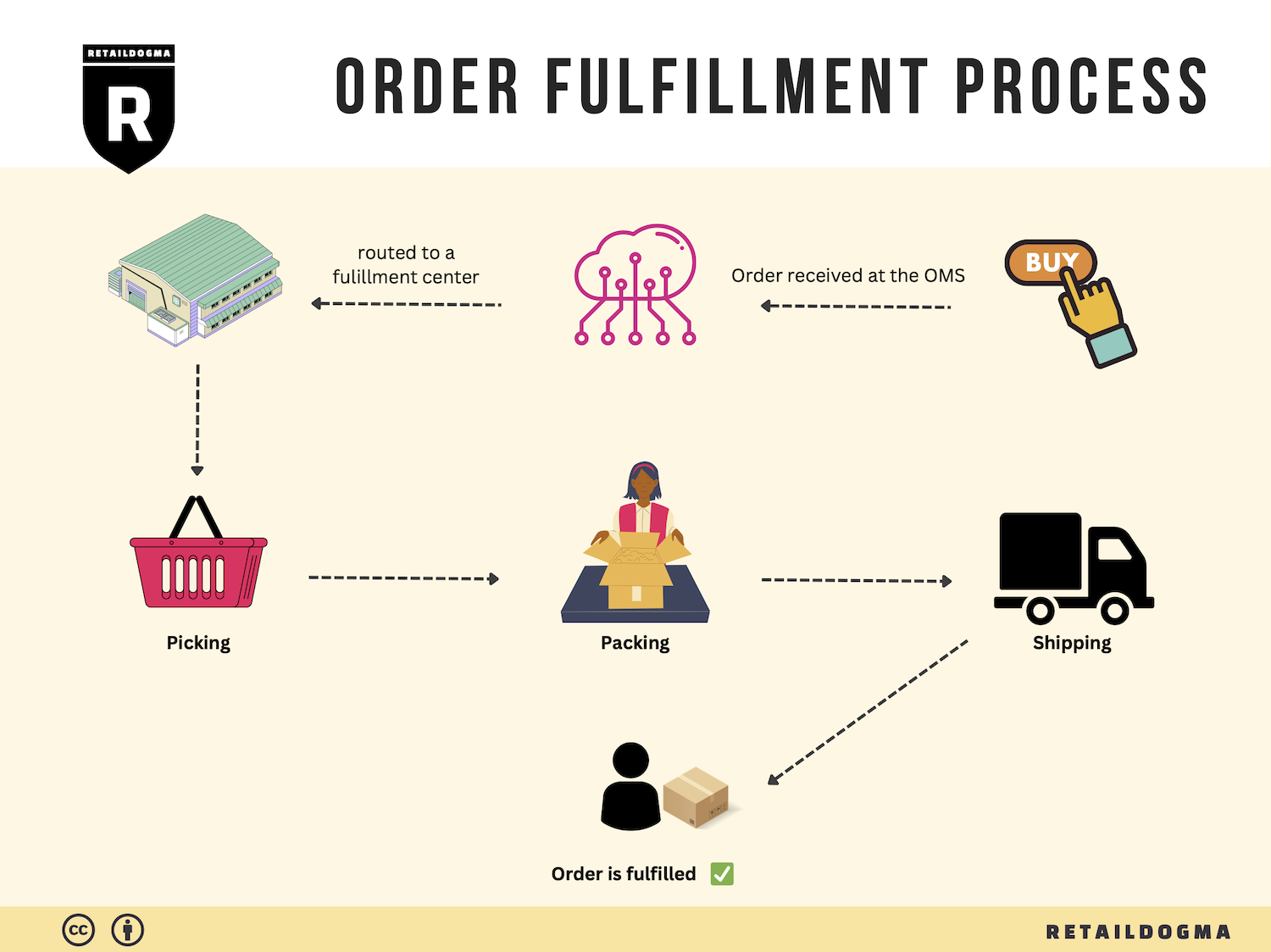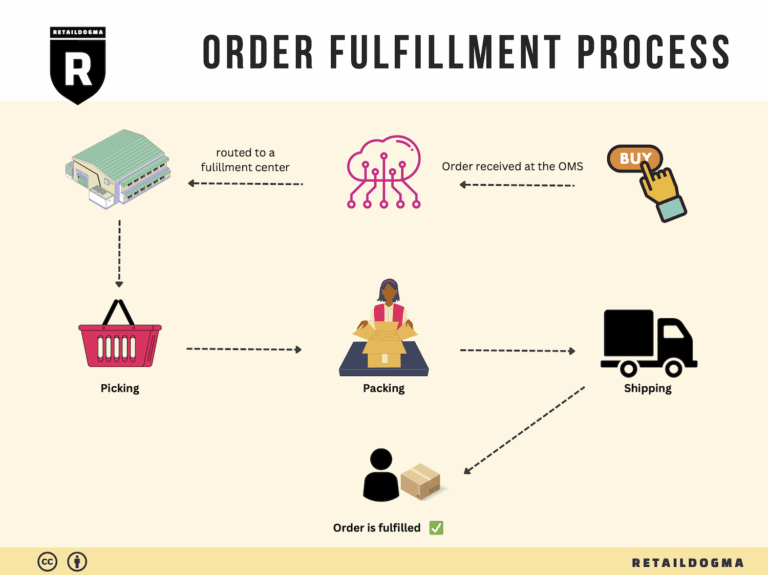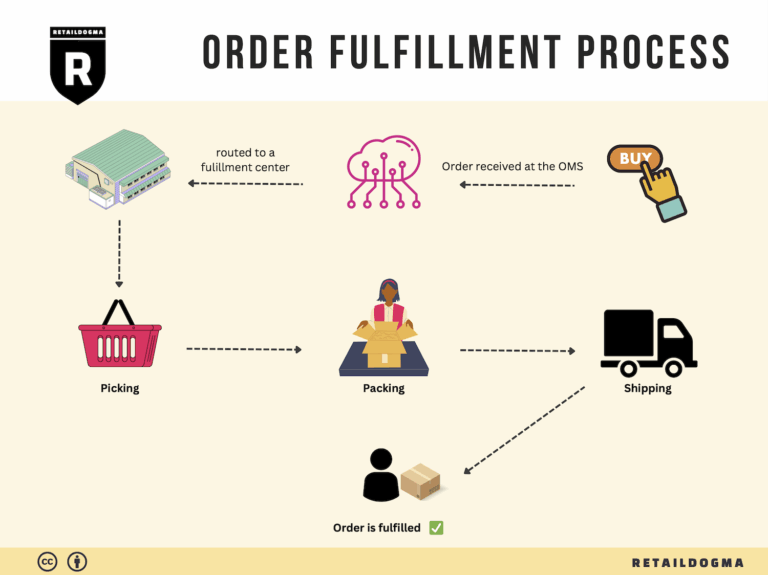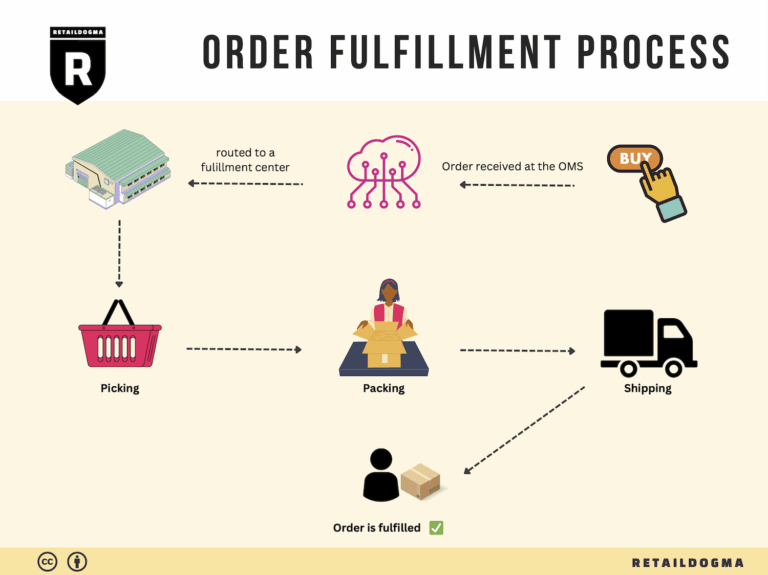What Is A Fulfillment Center? A Complete Guide (2025)
What is E-commerce Fulfillment? An Introduction for Growing Businesses
Understanding the Fulfillment Process
For many growing e-commerce businesses, the excitement of increased sales can quickly turn into overwhelm when it comes to packing and shipping orders. The fulfillment process—the journey of getting a product from your warehouse to your customer’s doorstep—can become a daunting task that distracts from your core business operations. This is especially true when you consider the various logistics involved: inventory management, order processing, packaging, shipping, and handling returns.
What is E-commerce Fulfillment?
In simple terms, e-commerce fulfillment is the process of receiving, processing, and delivering orders to customers. It encompasses everything from inventory storage to shipping logistics. As your business expands, the need for an efficient and scalable fulfillment strategy becomes critical. This guide aims to demystify the fulfillment process and provide you with actionable insights to streamline your operations.
Key Topics Covered
We will explore various fulfillment models that can suit your business needs, including:
-
Third-Party Logistics (3PL): Outsourcing your entire fulfillment process to a logistics provider can free up your time and resources, allowing you to focus on growth.
-
Fulfilled by Amazon (FBA): Utilizing Amazon’s vast network for storage and shipping can enhance your customer service and increase your visibility on the platform.
In addition to the different models, we will outline the core services involved in fulfillment, including:

-
Inventory Management: Techniques for tracking stock levels and managing replenishment.
-
Order Processing: Best practices for efficiently picking, packing, and shipping orders.
-
Returns Management: Strategies for handling returns to minimize losses and enhance customer satisfaction.
Choosing the Right Fulfillment Partner
Selecting the right fulfillment partner is a critical decision that can impact your business’s efficiency and customer satisfaction. We will discuss key considerations when evaluating potential partners, including their technology capabilities, service levels, and geographic reach.
Pricing Structures
Understanding the pricing structures associated with fulfillment services is essential for maintaining profitability. We will break down common pricing models, including per-order fees, storage fees, and shipping costs, to help you make informed financial decisions.
Empowering Your Business
Ultimately, this guide aims to empower you with the knowledge and tools necessary to make informed decisions about your logistics. By optimizing your fulfillment process, you can enhance customer satisfaction, reduce operational costs, and set the stage for sustainable growth.
What You’ll Learn In This Guide
- What is E-commerce Fulfillment? An Introduction for Growing Businesses
- The Order Fulfillment Process: From ‘Buy’ Button to Customer’s Door
- Comparing Fulfillment Models: In-House vs. 3PL vs. Dropshipping
- A Deep Dive into Amazon FBA: Pros, Cons, and Who It’s For
- Core Services Offered by Fulfillment Centers
- How to Choose a Fulfillment Partner: A 6-Point Checklist
- Understanding Fulfillment Pricing: A Breakdown of Common Fees
- Frequently Asked Questions (FAQs) about Fulfillment
- Conclusion: Is Outsourcing Fulfillment the Right Move for Your Business?
- Important Disclaimer
The Order Fulfillment Process: From ‘Buy’ Button to Customer’s Door
1. Receiving Inventory
The order fulfillment process begins with receiving inventory at the fulfillment center. This step involves the acceptance of products from suppliers or manufacturers. Each shipment is carefully checked against purchase orders to ensure accuracy and quality. Key terms associated with this process include SKU (Stock Keeping Unit), which helps track inventory and manage stock levels.
Receiving is crucial because it sets the stage for the entire fulfillment operation. Any discrepancies at this stage can lead to stockouts or overstock situations, both of which can negatively impact customer satisfaction and operational efficiency. Proper receiving procedures help maintain an accurate inventory count, reduce errors, and streamline subsequent steps in the fulfillment process.
2. Warehouse Storage
Once inventory is received and verified, the next step is warehouse storage. This involves placing products in designated storage areas within the fulfillment center. Efficient storage systems, such as FIFO (First In, First Out) and bin shelving, are often employed to optimize space and ensure that older stock is sold before newer inventory.
Warehouse storage is vital for maintaining organization and accessibility. Properly stored items can be retrieved quickly during the picking process, which is essential for meeting customer delivery expectations. Utilizing advanced inventory management systems can provide real-time visibility into stock levels, helping businesses to better forecast demand and manage reorder points.
3. Order Picking
The third step in the order fulfillment process is order picking, where items are selected from their storage locations to fulfill customer orders. This process often utilizes pick lists, which are generated based on the incoming orders and detail the specific items and quantities needed.
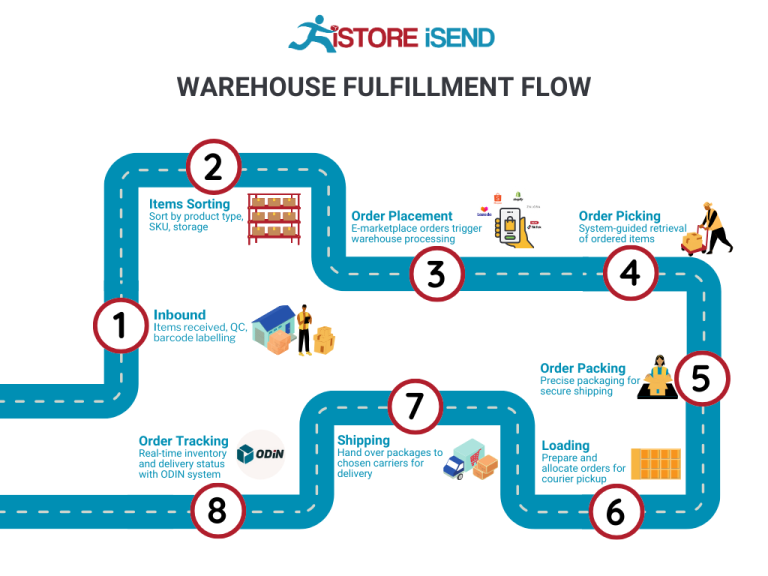
Order picking is significant as it directly impacts the speed and accuracy of fulfilling customer requests. Efficient picking methods, such as batch picking or zone picking, can enhance productivity and reduce labor costs. Technology, such as handheld scanners or automated picking systems, can further streamline this step, ensuring that the right items are picked without delay or error.
4. Order Packing
After items are picked, they move to the order packing stage. This involves carefully packaging the selected products to prevent damage during transit. Key considerations include choosing the right packaging materials and ensuring that the contents are securely packed. Terms like dimensional weight pricing often come into play, influencing packaging decisions based on shipping costs.
The packing process is crucial for customer satisfaction; well-packed orders minimize the risk of returns due to damage and enhance the overall unboxing experience for customers. Additionally, accurate packing ensures that all items ordered are included, reducing the likelihood of order discrepancies that can harm the retailer’s reputation.
5. Shipping & Delivery
The final step in the order fulfillment process is shipping and delivery. This involves preparing packed orders for dispatch and selecting the appropriate shipping carriers. Factors such as shipping speed, cost, and service reliability are assessed when choosing carriers. The use of tracking numbers is also vital, as it allows both the business and the customer to monitor the order’s journey.
Shipping and delivery are critical for customer satisfaction and retention. Timely delivery can significantly enhance the shopping experience, while delays can lead to frustration and lost sales. Implementing strategies like route optimization and leveraging multiple shipping options can help businesses scale their operations and meet increasing customer expectations for faster delivery.
By understanding and optimizing each step of the order fulfillment process, e-commerce businesses can improve efficiency, enhance customer satisfaction, and ultimately drive growth.
Comparing Fulfillment Models: In-House vs. 3PL vs. Dropshipping
Fulfillment Model Comparison
| Model | Who Handles Inventory | Best For (Business Stage) | Key Advantage | Key Disadvantage |
|---|---|---|---|---|
| In-House Fulfillment | The business itself | Established businesses | Full control over inventory and operations | High operational costs and management burden |
| Third-Party Logistics (3PL) | A third-party provider | Growing businesses | Scalability and reduced overhead | Less control over operations and inventory |
| Dropshipping | Suppliers/manufacturers | Startups and small businesses | Low upfront investment and risk | Lower profit margins and dependency on suppliers |
In-House Fulfillment
In-house fulfillment refers to the process where a business manages its own inventory, warehousing, and order processing. This model is typically adopted by established businesses that have the resources and infrastructure to handle logistics internally. By controlling the entire fulfillment process, businesses can maintain a high level of quality assurance, customize their packaging, and directly manage customer service. However, the key disadvantage of in-house fulfillment is the significant operational costs involved. These include expenses related to warehousing, labor, equipment, and technology, which can strain cash flow, especially for smaller businesses. Additionally, as order volumes increase, the complexity of operations can lead to inefficiencies if not managed properly.
Third-Party Logistics (3PL)
Third-party logistics (3PL) providers are specialized companies that manage logistics and fulfillment for businesses. This model is particularly beneficial for growing businesses looking to scale their operations without investing heavily in infrastructure. Partnering with a 3PL allows companies to leverage the provider’s expertise, technology, and network for inventory management, warehousing, and shipping. A significant advantage of using a 3PL is the ability to quickly adapt to market changes and increased demand without the burden of managing logistics directly. However, businesses may face challenges with less control over their inventory and fulfillment processes. This can lead to potential issues with order accuracy and customer satisfaction if the 3PL does not meet performance expectations.
Dropshipping
Dropshipping is a fulfillment model where the retailer does not keep goods in stock but instead transfers customer orders and shipment details to a manufacturer or wholesaler, who then ships the products directly to the customer. This model is ideal for startups and small businesses because it requires minimal upfront investment and eliminates the risks associated with unsold inventory. Additionally, dropshipping allows entrepreneurs to offer a wide range of products without the need for significant warehousing costs. However, the key disadvantage is that profit margins are typically lower compared to traditional retail models. Retailers also become reliant on their suppliers for product quality and shipping times, which can lead to inconsistencies and potential customer dissatisfaction if suppliers fail to deliver as promised.
Conclusion
Choosing the right fulfillment model is crucial for e-commerce businesses aiming to scale effectively. Each model has its unique benefits and drawbacks, and the best choice will depend on factors such as business size, growth stage, and operational capabilities. In-house fulfillment offers control but at a higher cost, while 3PL provides scalability with some loss of control. Dropshipping minimizes risk but can lead to lower margins and dependency on suppliers. By carefully evaluating these options, businesses can align their fulfillment strategy with their growth objectives and customer expectations.
A Deep Dive into Amazon FBA: Pros, Cons, and Who It’s For
Understanding Fulfillment by Amazon (FBA)
Fulfillment by Amazon (FBA) is a service that allows e-commerce sellers to store their products in Amazon’s fulfillment centers. Amazon takes care of storage, packaging, shipping, and customer service on behalf of the sellers. This service enables businesses to leverage Amazon’s vast logistics network and customer trust, allowing them to scale their operations efficiently.
How FBA Works
-
Product Listing: Sellers create product listings on Amazon, just like any other seller. They can choose to fulfill orders themselves or opt for FBA.
-
Inventory Shipment: Sellers ship their products to Amazon’s fulfillment centers, such as the LGA9 facility in Edison, NJ. Amazon provides guidance on how to prepare and package items for shipment.
-
Storage: Once received, the products are stored in Amazon’s warehouses. Sellers can monitor their inventory levels through their Amazon Seller Central account.
-
Order Fulfillment: When a customer places an order, Amazon picks, packs, and ships the product directly to the customer. This process is streamlined and efficient, ensuring quick delivery.
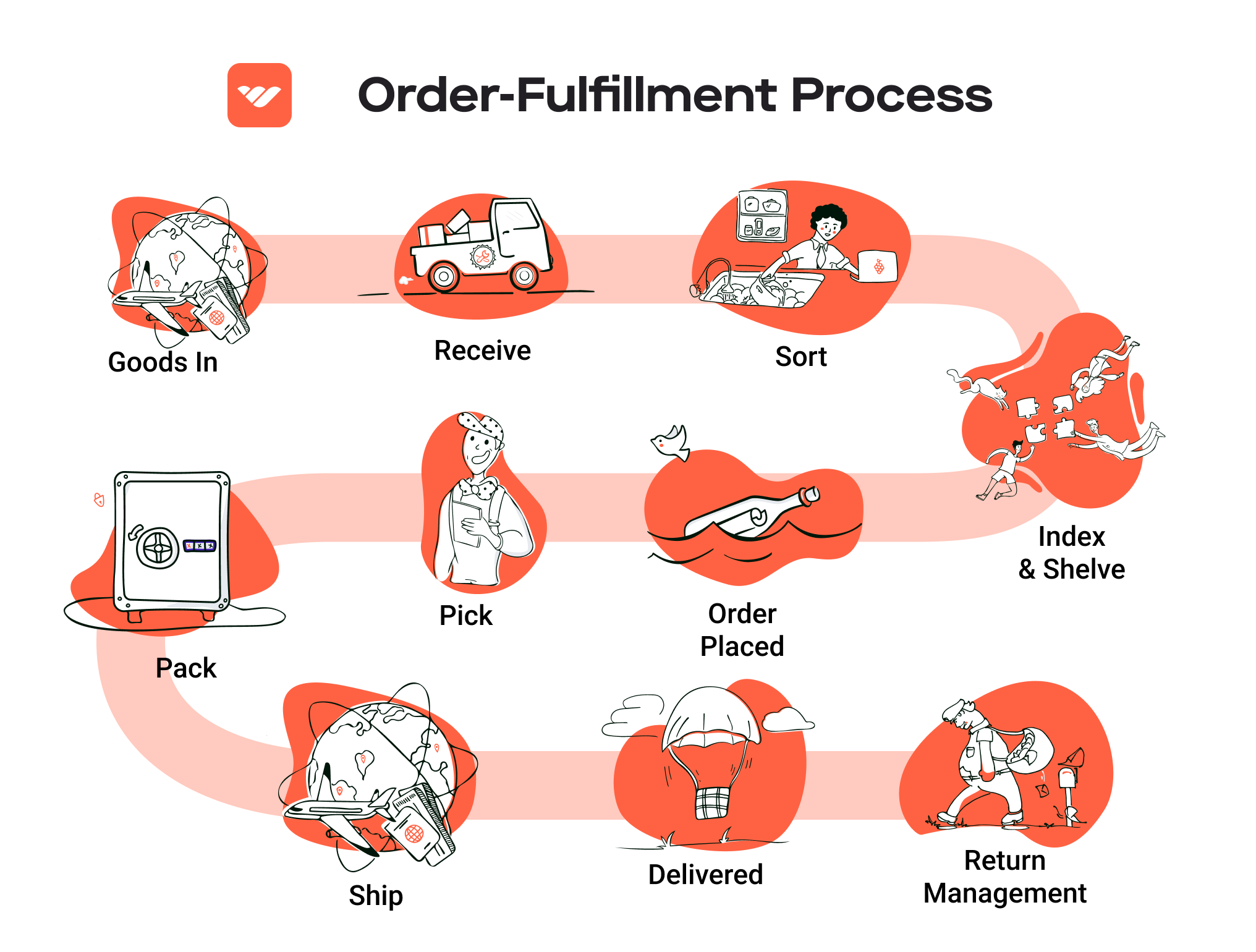
-
Customer Service: Amazon also handles customer inquiries and returns, allowing sellers to focus on other aspects of their business.
-
Sales Reporting: Sellers can access detailed reports on sales, inventory levels, and performance metrics through the Seller Central dashboard.
Pros of Using FBA
-
Prime Eligibility: Products fulfilled by Amazon are automatically eligible for Amazon Prime, increasing visibility and attracting more customers. Prime members tend to have higher conversion rates due to the fast, free shipping options.
-
Customer Trust: Amazon has built a strong reputation for reliability and customer service. By using FBA, sellers can benefit from this trust, making customers more likely to purchase their products.
-
Multi-Channel Fulfillment: FBA isn’t limited to Amazon sales alone. Sellers can use FBA to fulfill orders from other platforms, such as their own websites or eBay, simplifying logistics and inventory management.
-
Scalability: FBA allows businesses to scale quickly without the need to invest heavily in logistics infrastructure. Sellers can focus on marketing and product development while Amazon manages fulfillment.
-
Time Savings: Outsourcing fulfillment to Amazon frees up time for sellers, allowing them to concentrate on growing their business rather than managing shipping and customer service.
Cons of Using FBA
-
High Fees: FBA comes with various fees, including storage fees and fulfillment fees, which can eat into profit margins. Sellers need to carefully analyze these costs to ensure their pricing strategy remains competitive.
-
Strict Inventory Rules: Amazon has specific guidelines for inventory management, including restrictions on certain products and the requirement to maintain a certain level of inventory. Non-compliance can lead to penalties or removal from the program.
-
Commingling Risks: FBA products may be commingled with those from other sellers, which can pose risks in terms of inventory tracking and quality control. If a customer returns a defective item, it could impact the seller’s reputation even if the issue is with another seller’s product.
-
Loss of Control: By using FBA, sellers relinquish some control over the fulfillment process. They must rely on Amazon’s systems and procedures, which may not always align with their business practices.
-
Complex Returns Process: While Amazon handles returns, this can complicate inventory tracking. Sellers may find it challenging to manage returned items and restock them appropriately.
Who is FBA Best For?
Fulfillment by Amazon is best suited for:
-
Small to Medium-Sized Businesses: Companies that lack the infrastructure for logistics and customer service can benefit significantly from FBA, allowing them to compete with larger retailers.
-
Sellers with High Sales Volume: Businesses that sell a large number of products can take advantage of Amazon’s shipping capabilities and customer base to maximize sales.
-
Niche Product Sellers: If you offer unique or niche products, FBA can help you reach a broader audience through Amazon’s platform while managing logistics effectively.
-
Entrepreneurs Looking to Scale: For those who want to expand quickly without the headache of managing fulfillment, FBA provides a scalable solution that allows for rapid growth.
-
Multi-Channel Sellers: Businesses that sell on multiple platforms can simplify their fulfillment processes by using FBA to handle logistics across all sales channels.
In conclusion, while Fulfillment by Amazon offers numerous advantages that can significantly streamline operations and increase sales potential, it is essential for sellers to weigh these benefits against the associated costs and risks. By understanding how FBA works and who it is best for, e-commerce business owners can make informed decisions to support their growth strategies effectively.
Core Services Offered by Fulfillment Centers
Inventory Management & Warehousing
Inventory management is a critical component of e-commerce operations, and fulfillment centers like LGA9 in Edison, NJ, offer sophisticated solutions to streamline this process. These centers provide extensive warehousing capabilities, allowing businesses to store a wide range of products in a secure and organized environment.
What It Is: Fulfillment centers use advanced inventory management systems to track stock levels, manage reordering, and monitor product turnover rates. This ensures that businesses can maintain optimal inventory levels without overstocking or running out of popular items. Facilities are equipped with technology that allows for real-time visibility into inventory, often integrating with e-commerce platforms for seamless data flow.
Benefits to E-Commerce Businesses: By outsourcing inventory management to a fulfillment center, e-commerce businesses can focus on growth and marketing rather than the complexities of warehousing. This service reduces the risk of inventory-related issues such as spoilage or obsolescence, ultimately leading to cost savings. Furthermore, the ability to scale storage capacity easily allows businesses to adapt to seasonal fluctuations in demand without the burden of long-term leases or investments in warehouse infrastructure.
Pick and Pack Services
Pick and pack services are at the heart of the fulfillment process, where orders are prepared for shipping after customers make purchases online.
What It Is: In this service, fulfillment center staff (or automated systems) pick the ordered items from inventory and package them for delivery. This may involve selecting the correct quantity of products, ensuring they are in good condition, and packing them securely to minimize damage during transit. Advanced fulfillment centers utilize technology such as barcode scanning and automated picking systems to enhance accuracy and efficiency.
Benefits to E-Commerce Businesses: Outsourcing pick and pack services significantly speeds up order processing times, which is crucial in today’s fast-paced e-commerce environment. Customers expect quick deliveries, and fulfillment centers can help businesses meet these expectations. Additionally, the reduction in human error leads to improved customer satisfaction and fewer returns due to incorrect orders. The efficiency gained from these services enables businesses to handle larger volumes of orders without a proportional increase in operational complexity.
Kitting and Assembly
Kitting and assembly services involve grouping together various products into a single package or preparing items for sale.
What It Is: This service is particularly beneficial for businesses that sell products that require assembly or need to be bundled together for promotional purposes. For example, a fulfillment center might assemble a gift set that includes multiple items, or it might prepare products for a subscription box service. Kitting can also include labeling and packaging tasks that make the final product ready for sale.
Benefits to E-Commerce Businesses: Kitting and assembly streamline the process of preparing complex orders, enabling businesses to offer customized solutions to their customers. This service can enhance the perceived value of products, as customers appreciate thoughtfully packaged items. Moreover, by outsourcing this function, businesses can reduce labor costs and free up internal resources for other strategic initiatives. It also allows for flexibility in product offerings, making it easier to launch promotions or seasonal items without extensive in-house labor.
Returns Management (Reverse Logistics)
Returns management, often referred to as reverse logistics, is a crucial service provided by fulfillment centers to handle product returns efficiently.
What It Is: This involves the processing of returned items, including inspecting, restocking, or refurbishing products that customers have sent back. A well-organized returns management system helps businesses understand return reasons, manage inventory levels, and reduce losses associated with unsold or damaged merchandise.
Benefits to E-Commerce Businesses: Effective returns management enhances customer satisfaction by providing a hassle-free return process, which is a significant factor in purchasing decisions for many online shoppers. By utilizing a fulfillment center’s expertise in reverse logistics, businesses can minimize the costs associated with returns and improve their overall return rate. Additionally, insights gained from analyzing return data can inform product development, marketing strategies, and inventory decisions, helping businesses to better meet customer needs and reduce future returns.
Conclusion
Utilizing a fulfillment center like LGA9 in Edison, NJ, can greatly enhance the operational efficiency of e-commerce businesses. By leveraging core services such as inventory management, pick and pack, kitting and assembly, and returns management, businesses can focus on growth while ensuring that their logistics are handled expertly. This strategic partnership not only optimizes supply chain operations but also contributes to improved customer experiences, ultimately leading to increased sales and profitability.
How to Choose a Fulfillment Partner: A 6-Point Checklist
Location & Warehouse Network
Why It’s Important:
The geographical location of your fulfillment partner is crucial for optimizing shipping times and costs. A partner situated near your customer base can significantly reduce delivery times, enhancing customer satisfaction. Additionally, a strong warehouse network allows for better distribution and inventory management.
Questions to Ask:
– What is the location of your warehouses, and how do they align with my target customer demographics?
– Can you provide details on your logistics network and how it impacts shipping times?
– How do you manage inventory across multiple locations?
Technology & Integrations
Why It’s Important:
In today’s digital landscape, the technology used by your fulfillment partner can either streamline your operations or create bottlenecks. An effective partner should offer robust technology solutions that integrate seamlessly with your e-commerce platform, inventory management systems, and other business tools.
Questions to Ask:
– What technology platforms do you use for order management, inventory tracking, and shipping?
– Can your systems integrate with my existing e-commerce platform (e.g., Shopify, WooCommerce, Amazon)?
– Do you offer real-time tracking and reporting tools for inventory and shipments?
Specializations (e.g., Cold Storage, Oversized Items)
Why It’s Important:
Not all fulfillment centers are equipped to handle every type of product. If your business requires specialized storage, such as cold storage for perishables or handling oversized items, it’s essential to choose a partner with the right capabilities.
Questions to Ask:
– Do you have experience in handling my specific product types (e.g., perishables, hazardous materials, oversized items)?
– What specialized equipment or facilities do you offer to accommodate my products?
– Can you provide case studies or references from similar businesses in my industry?
Scalability & Capacity
Why It’s Important:
As your business grows, your fulfillment needs may change. A good partner should not only meet your current requirements but also be able to scale operations efficiently to accommodate growth without compromising service quality.
Questions to Ask:
– How do you handle peak seasons and sudden spikes in order volume?
– Can you provide insights into your capacity limits and how you manage overflow?
– What are your plans for expansion, and how will that benefit my business in the future?
Pricing and Contracts
Why It’s Important:
Understanding the cost structure of your fulfillment partner is vital for budgeting and profitability. Transparent pricing helps avoid unexpected costs and enables better financial planning. Additionally, the terms of contracts can impact flexibility and long-term partnerships.
Questions to Ask:
– What is your pricing model (e.g., per order, per item, flat rate), and what does it include?
– Are there any hidden fees (e.g., for storage, returns, or special handling)?
– Can you explain the contract terms regarding termination, renewal, and price increases?
Customer Support & Reviews
Why It’s Important:
Effective customer support can make or break your relationship with a fulfillment partner. Quick and reliable communication is essential, especially when resolving issues or during peak seasons. Additionally, reviews and references can provide insight into a partner’s reliability and service quality.
Questions to Ask:
– What is your customer support structure (e.g., dedicated account manager, 24/7 support)?
– How do you handle issues or disputes that arise during the fulfillment process?
– Can you provide references or testimonials from current or past clients?
By carefully considering these six points when selecting a fulfillment partner, you can ensure that your logistics operations are efficient, scalable, and aligned with your business goals. This checklist serves as a foundational tool for e-commerce business owners, operations managers, and entrepreneurs seeking to enhance their fulfillment strategies and scale their operations effectively.
Understanding Fulfillment Pricing: A Breakdown of Common Fees
Initial Setup Fees
Initial setup fees are one-time charges that e-commerce businesses incur when they first partner with a fulfillment center like Amazon’s LGA9 facility. These fees cover the costs associated with onboarding, such as establishing your account, integrating your inventory management systems, and setting up any necessary software.
The calculation of initial setup fees can vary widely based on the complexity of the integration and the specific requirements of your business. Some fulfillment centers may charge a flat fee, while others might base the cost on the number of SKUs you plan to manage. It’s crucial to ask potential partners for a detailed breakdown of these fees to avoid surprises.
Receiving Fees
Receiving fees are incurred when your products arrive at the fulfillment center. This charge typically covers the labor costs associated with unloading, inspecting, and sorting incoming inventory.
Receiving fees are generally calculated per unit or per pallet, depending on how your goods are shipped. For example, if you send a pallet of 100 items, you might be charged a flat rate for the entire pallet or a per-item fee. To manage these costs effectively, consider consolidating shipments to minimize the number of receiving transactions.
Storage Fees (per pallet/bin)
Storage fees are ongoing charges for keeping your inventory at the fulfillment center. These fees are typically calculated on a monthly basis and can be based on the volume of space your products occupy, either per pallet or per bin.
At Amazon’s LGA9 facility, for instance, you might find that the storage fees are tiered, meaning the more inventory you store, the lower the per-pallet cost. Businesses should monitor their inventory levels closely to optimize storage costs. Excessive inventory can lead to higher fees, so it’s beneficial to implement just-in-time inventory practices.
Pick & Pack Fees (per item/order)
Pick and pack fees are charged for the labor involved in retrieving items from storage and packing them for shipment. This fee is usually calculated on a per-item or per-order basis.
For example, if a customer orders three different items, you may incur a pick fee for each item, plus a packing fee for the order. Some fulfillment centers offer tiered pricing for pick and pack services; the more items you ship, the less you pay per item. Businesses can reduce these fees by optimizing their order sizes or utilizing kitting services, where multiple items are packaged together in advance.
Shipping Fees
Shipping fees are perhaps the most variable component of fulfillment pricing. These fees cover the cost of transporting goods from the fulfillment center to the customer. Shipping costs can fluctuate based on several factors, including the shipping method chosen (standard, expedited, etc.), the destination of the shipment, and the weight and dimensions of the package.
Fulfillment centers often offer discounted shipping rates through partnerships with major carriers, which can help e-commerce businesses save on shipping costs. It’s advisable to compare shipping options and analyze historical shipping data to select the most cost-effective methods for your business.
Tips for Getting an Accurate Quote
-
Detailed Inventory List: Provide a comprehensive list of your SKUs, including dimensions and weights. This information helps fulfillment centers give you accurate storage and shipping quotes.
-
Volume Estimates: Share your sales forecasts or historical data to allow for better estimates on receiving, storage, and pick & pack fees.
-
Clarify Services Needed: Clearly outline all services you require, such as kitting, labeling, or returns processing, as additional services can impact pricing.
-
Ask for Transparency: Request a detailed breakdown of all fees associated with your account. This transparency will help you understand potential costs and avoid hidden charges.
-
Negotiate Terms: Don’t hesitate to negotiate terms and pricing, especially if you anticipate high volumes. Fulfillment centers may offer discounts for long-term contracts or higher volumes.
By understanding these common fees and how they are calculated, e-commerce businesses can better manage their fulfillment costs and optimize their logistics strategies for growth.
Frequently Asked Questions (FAQs) about Fulfillment
1. What is the LGA9 Amazon Fulfillment Center?
The LGA9 Amazon Fulfillment Center, located at 2170 State Route 27, Edison, NJ, is a large-scale logistics facility specializing in the storage, packing, and shipping of a diverse range of products for Amazon. Its operations are crucial in ensuring timely deliveries across the region, leveraging advanced technology and efficient processes.
2. How does the fulfillment process work at LGA9?
At LGA9, the fulfillment process begins when an order is placed on Amazon. The center uses a combination of manual labor and robotics to pick, pack, and ship items. Products are stored in a systematic manner that allows for quick retrieval, with robots assisting in transporting goods to packing stations, ensuring efficiency and speed.
3. What’s the difference between a warehouse and a fulfillment center?
A warehouse primarily focuses on storing goods, while a fulfillment center is designed to handle the entire order processing cycle. This includes receiving inventory, storing products, picking and packing orders, and shipping them directly to customers. Fulfillment centers, like LGA9, are optimized for fast and efficient order fulfillment to meet customer demand.
4. What is a 3PL, and how does it relate to fulfillment?
A 3PL, or third-party logistics provider, is a service that manages various logistics processes for businesses, including warehousing, fulfillment, and distribution. Companies can partner with a 3PL to handle their supply chain needs, allowing them to focus on their core business while benefiting from the expertise and resources of the 3PL. LGA9 operates as part of Amazon’s logistics network, but businesses may also use independent 3PLs for their fulfillment needs.
5. How much do fulfillment services cost?
Fulfillment service costs vary based on several factors, including the volume of orders, the types of products being handled, and the specific services required (such as packing, shipping, and storage). On average, businesses can expect to pay for storage fees, picking and packing fees, and shipping costs. It’s advisable to request quotes from fulfillment centers to get a clearer picture of potential costs.
6. What types of products can be stored at the LGA9 Fulfillment Center?
The LGA9 Fulfillment Center is capable of storing a wide variety of products, from small consumer electronics to household items. However, there are restrictions on hazardous materials, perishables, and other items that require special handling. It’s important for sellers to check Amazon’s guidelines to ensure their products are eligible for storage and fulfillment at this facility.
7. Can I tour the LGA9 Fulfillment Center?
Yes, the LGA9 Fulfillment Center offers in-person tours that allow visitors to see the operations firsthand. Tours typically last 60-90 minutes and are designed to give an overview of how Amazon manages its fulfillment processes. Registration is required, and specific safety guidelines must be followed during the visit.
8. What are the safety measures in place at the LGA9 Fulfillment Center?
Safety is a top priority at the LGA9 Fulfillment Center. Employees and visitors must adhere to strict safety protocols, including wearing appropriate attire (closed-toed shoes, long pants) and following safety instructions. Regular safety training and equipment checks are conducted to minimize risks in the active work environment.
9. How does LGA9 handle peak season demand?
During peak seasons, such as holidays, the LGA9 Fulfillment Center ramps up its operations to meet increased demand. This may involve hiring additional staff, optimizing storage space, and enhancing technology systems to ensure efficient processing of a higher volume of orders. Businesses utilizing the center can benefit from these scalable solutions to manage seasonal spikes in demand.
10. What are the advantages of using the LGA9 Fulfillment Center for my e-commerce business?
Utilizing the LGA9 Fulfillment Center offers numerous advantages, including access to Amazon’s extensive logistics network, faster shipping options, and enhanced customer service. By outsourcing fulfillment to Amazon, e-commerce businesses can streamline their operations, reduce shipping times, and potentially lower costs, allowing them to focus on growth and customer engagement.
Conclusion: Is Outsourcing Fulfillment the Right Move for Your Business?
Evaluating the Benefits of Outsourcing Fulfillment
Outsourcing fulfillment can be a game-changer for e-commerce businesses looking to scale efficiently. The primary advantage lies in the significant time savings it provides. By delegating warehousing, packing, and shipping tasks to a third-party fulfillment center like the LGA9 Amazon Fulfillment Center in Edison, NJ, you can focus more on strategic initiatives such as marketing and product development. This shift allows you to redirect your efforts toward growth rather than getting bogged down in logistical challenges.
Scalability is another compelling reason to consider fulfillment services. As your sales volume increases, so do the complexities of managing inventory and order processing. Partnering with a capable fulfillment provider enables you to effortlessly scale your operations without the need for substantial investments in infrastructure or personnel. This flexibility can be especially advantageous during peak seasons or promotional events, where demand can fluctuate dramatically.
Moreover, fulfillment partners bring expertise to the table. Their experience in logistics means they are well-versed in optimizing shipping routes, managing returns, and ensuring compliance with regulatory requirements. This knowledge not only helps in maintaining customer satisfaction through timely deliveries but can also lead to cost efficiencies that you might not achieve in-house.
However, selecting the right fulfillment partner is crucial for your business’s success. A misalignment in values, capabilities, or service levels can hinder your growth rather than facilitate it. Take the time to research potential partners, assess their technology and processes, and ensure they align with your operational goals.
Take Action Today
Now is the time to evaluate your current shipping processes. Conduct an audit of your logistics operations to determine if outsourcing fulfillment could enhance your efficiency and support your growth ambitions. If you’re feeling overwhelmed by your current setup, consider reaching out to a fulfillment expert to discuss how they can help streamline your operations and elevate your business to the next level.
Important Disclaimer
⚠️ Important Disclaimer
The information in this guide is for educational purposes. Fulfillment services, pricing, and platform features change frequently. Always conduct your own due diligence and consult with providers directly before making business decisions.
